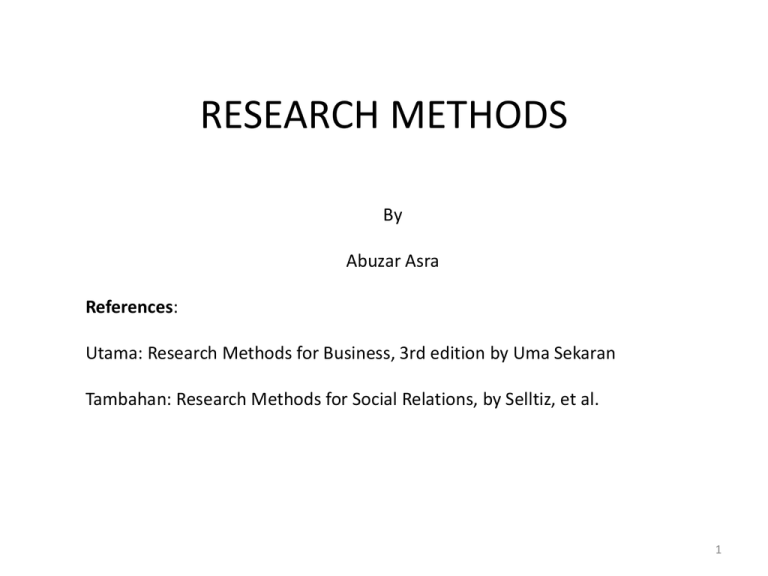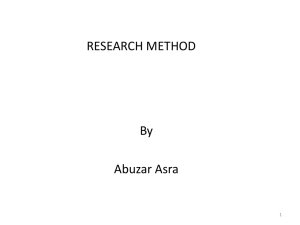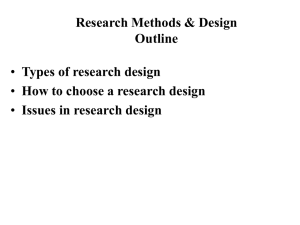SESSION 1A-INTRODUCTION
advertisement

RESEARCH METHODS By Abuzar Asra References: Utama: Research Methods for Business, 3rd edition by Uma Sekaran Tambahan: Research Methods for Social Relations, by Selltiz, et al. 1 SESSION 1A: INTRODUCTION TO RESEARCH I. Nature of Research II. What is Research III. Functions of Research 2 I. NATURE OF RESEARCH (1) (Selltiz, et al., 1976) - research: to search again, to take another, more careful look, to find out more -presumption: first look, and every other look, may be prone to error -not just ‘finding out something you do not know’, but ‘finding that you do not know something’ 3 I. NATURE OF RESEARCH (2) -Just looking does not always yield valid conclusions Ex. A Spanish ship set sail and thend disappeared below horizon Columbus: believed the world was round, the ship taking its first curve around the world King Ferdinand: was relatively flat, or at least hump-backed, like a turtle, seeing it disappearing from view. 4 I. NATURE OF RESEARCH (3) - intelligence-gathering versus research: Intelligence gathering: ‘what’ question, descriptive, is not research Research: ‘why’ question, analysis (explanations, relationships, comparisons, predictions, generalisations, and theories) 5 I. NATURE OF RESEARCH (4) While very kind of human reaction is conceivable, not everyone can conceive every kind of reaction. (Selltiz, et al., 1976) A riddle: A man and his son are in a automobile accident. The man is killed and the boy, seriously injured, is rushed to the hospital for surgery. But the surgeon takes one look at him and says, “I am sorry I can’t operate on this boy. He is my son”. According to the riddle, the boy’s father is dead and the surgeon is telling the truth. How can that be? 6 I. NATURE OF RESEARCH (5) Cyclical nature of scientific method: facts (INDUCTION) (DEDUCTION) theories consequences (VERIFICATION) new facts 7 I. NATURE OF RESEARCH (6) Four ways of knowing: Method of Tenacity Truth is true because one believes it, even in front of contradicting evidence. Superstition. Method of Authority Truth is true because an authority says so. Religion. Method of Intuition Truth is true because it is logical. Derived from reasoning but does not bear empirical support. Philosophy. Method of Science Accounts for solvable problems that have empirical solutions based on observable events 8 II. WHAT IS RESEARCH • Research: the process of finding solutions to a problem after a thorough study and analysis of the situational factors • Business Research: an organized, systematic, databased, critical, objective, scientific inquiry or investigation into a specific problem, undertaken with the purpose of finding answers or solutions to it (Sekaran, 2000) 9 III. FUNCTIONS OF (SOCIAL) RESEARCH (1) (Selltiz, et al., 1976) • To develop and evaluate practices, concepts, theories of (social) relations and to develop and evaluate methodologies that test these practices, concepts, theories. • To improve the quality of (social) life. • To develop measures of the quality of life, such as social indicators 10 III. FUNCTIONS OF (BUSINESS) RESEARCH (2) • To investigate a specific problem encountered in the work setting, that needs a solution Process involved: inquiry, investigation, examination, and experimentation 11 IV. TYPES OF (BUSINESS) RESEARCH (1) (Sekaran, 2000 and Johnston, 1986) • Basic/fundamental/pure research: chiefly to enhance the understanding of certain problems and seek methods of solving them (i.e contribute to knowledge building in a certain area), similar to - Disciplinary research to improve a discipline, such as economics 12 IV. TYPES OF (BUSINESS) RESEARCH (2) (Sekaran, 2000 and Johnston, 1986) •Applied research: applying the results of the findings to solve specific problems currently being faced, similar to, - Subject-Matter: multidisciplinary research on a subject of interest to a set of decision makers facing a set of practical problems or - Problem-solving To solve a specific problem for a specific decision makers 13






